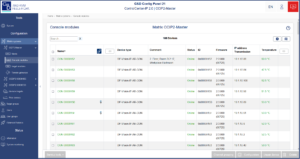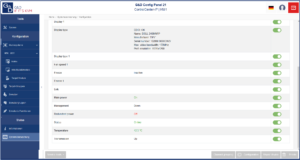KVM products from G&D are extremely versatile. That’s why it may happen that you are still unfamiliar with one or two of their features. Our blog series aims to shed some light on this. The first and the second part focused on the best features for users. In the third part, we showed some benefits for admins. In our fourth and final blog post of this series, we’ll tell you which other features are relevant for admins. You’ll also learn why the Move feature brings your process security to perfection and what great little details are still hiding in our devices.
9. Comment function
You can use comment fields to store information about the connected computers or the CPU modules. Since you see the comments together with the CPU names also in the select window, you can also use comments as an extension of the name field. This way, unnecessary notes are a thing of the past.
10. Configurable monitoring values
G&D KVM components regularly check their own status. For example, you can monitor the status of the video interface or the power supplies and see it in the web interface. If a value does not provide the target state when you turn on the KVM product and the computer, an alarm message appears in the web interface. However, if you do not use a redundant power supply, for example, this value is permanently displayed as an alarm.
Since you can configure the monitoring values yourself, only the values that are relevant to you are monitored. Indeed, if an error message appears, it is a real error message. The configurable monitoring values ensure that irrelevant error messages no longer distract you, as they only appear in an emergency.
11. Move function (direct connection)
Using the Move function, you can transfer the configuration settings of all matrix components from one module to another in one step. You can do this either via OSD or via web interface, depending on your preference. Therefore, if you need to replace a CPU or CON module, users need to be able to get the computer back up and running as quickly as possible. Complex access rights, group memberships and other settings are bound to the unique ID of a CPU module. Unfortunately, this information is difficult to remember. However, the Matrix database would store this information even after a CPU module has failed. The Move function links this database entry to the unique ID of the replacement module. Now the operator can use the computer as usual in the shortest possible time.
We hope our blog series has shown you some of the features that make your job a little easier. If you missed any of the posts in this series, you can read them here:
- 11 great little KVM features that are desperate to prove their usefulness more often – Part 1
- 11 great little KVM features that are desperate to prove their usefulness more often – Part 2
-
11 great little KVM features that are desperate to prove their usefulness more often – Part 3
For more information, please visit our Website, www.gdsys.com.
- 40 Years – 4 Perspectives: G&D through Four Different Lenses - 16. December 2025
- Trusted. Improved. VisionXS 2.0 - 15. October 2025
- bluedec™ – Our Video Compression for Control Rooms, Now Even More Powerful - 2. September 2025



